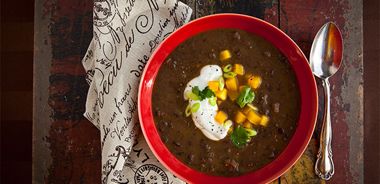Cowboy Black Bean Soup

This hearty soup makes a perfect cold weather lunch or light dinner paired with a kale salad.
1 lb (450 g) dried black beans (about 2 cups/500 mL)
1 Tbsp (15 mL) coconut oil
1 cup (250 mL) diced onion
1 red bell pepper, diced
2 large celery stalks, thinly sliced across the stalk
1/2 cup (125 mL) carrot, diced
1 jalapeno pepper, seeded and finely diced
3 garlic cloves, minced
2 tsp (10 mL) ground cumin
1 tsp (5 mL) smoked paprika
1 bay leaf
4 cups (1 L) water
2 cups (500 mL) brewed coffee
2 cups (500 mL) butternut squash, cut into 1/2 in (1.25 cm) cubes
1/2 tsp (2 mL) salt
2 green onions, trimmed and thinly sliced
6 Tbsp (90 mL) reduced-fat sour cream
1/4 cup (60 mL) fresh cilantro leaves
Pick over beans, making sure to discard any stones or broken beans. Rinse well, place in large bowl or container, and cover with 2 in (5 cm) cold water. Let beans soak overnight.
Heat oil in large pot over medium heat for 2 minutes. Add onion, pepper, celery, carrot, jalapeno, and garlic. Cook, stirring frequently, until vegetables begin to soften, about 8 minutes. Stir in cumin, smoked paprika, and bay leaf, cooking for another minute. Pour in water and coffee.
Drain beans, rinse well, and stir into soup base. Turn heat up to high and bring soup to a boil. Reduce heat to a simmer and skim off any foam that accumulates on surface. Cover pot and simmer, stirring occasionally, until beans are very tender, about 1 hour.
Meanwhile, steam squash until just cooked, about 5 minutes.
Once beans are cooked, remove pot from heat. Remove bay leaf from soup and stir in salt. Purée about half the soup in blender until smooth. Return purée to pot and stir until incorporated.
When ready to serve, warm soup gently over medium heat, stirring often, until warm. Ladle into bowls and garnish with cooked squash, a sprinkle of green onion, a dollop of sour cream, and a few torn cilantro leaves.
Serves 6.
Each serving contains: 329 calories; 18 g protein; 3 g total fat (2 g sat. fat, 0 g trans fat); 60 g total carbohydrates (6 g sugars, 21 g fibre); 239 mg sodium
source: "Cooking with Coffee", alive #373, November 2013





